The ‘Green Mountain state’ of Vermont has got thousands of acres of mountain forests, lowland valleys, and more… it’s a birder’s place to be and today we are going to talk about the popular backyard birds which you can see there. We’ll let you know how they look, what they eat, and where to find them but the rest is going to be up to you. Let’s talk about the popular backyard birds of Vermont!
3 Categories – 260 Birds
Vermont is home to over 260 different Avian species so you will want to keep an eye out, because these birds are ready and waiting to be spotted. To aid you in getting started we are going to give you a sampling of birds and separate them out like this:
- Year-round Resident birds
- Birds of Spring, Summer, and Early Fall
- Fall and Winter Birds
Once you know when to look and where to look then you’ll be surprised how many birds that you will see. We’ll go into their regional preferences and let you know which trees and other geographical features they favor. The rest, of course, is up to those birds and you!
Vermont’s Year-round Resident birds
We’ll start with Vermont’s permanent resident birds and they are a lovely bunch of characters. The birds in this category may be seen at any time of the year and most of them are quite ready and willing to visit a well-stocked backyard feeder. See if you can spot one of these year-round resident birds this year:
- Black-capped Chickadee
- American Goldfinch
- Mourning Dove
- Northern Cardinal
- Blue Jay
Black-capped Chickadee – Poecile atricapillus
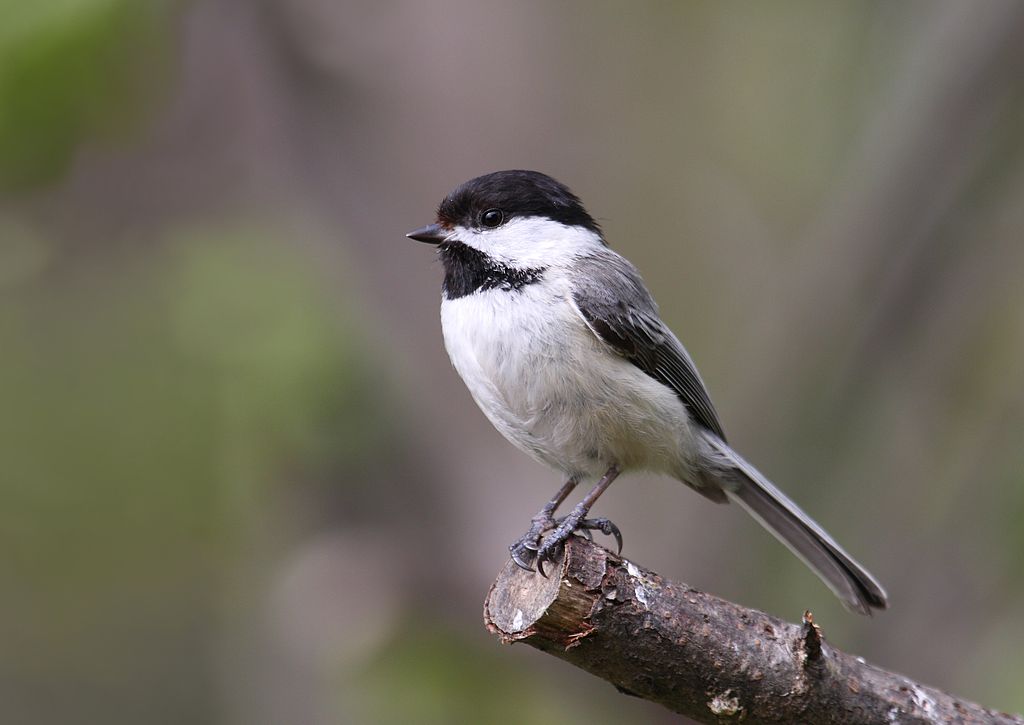
Coloration and Markings: Black-capped Chickadees have gray backs with short, gray wings that have a little white edging present, and long, thin gray tails with white outer feathers. The underbelly and breast of this bird are white, with a flanking of light, tan coloration present just below the wings, and facially, they have a white face with a small, black bib and a large, black cap which settles over much of the head, terminating at mid-eye level. These birds have tiny, triangular black bills.
Size: These birds measure in at 4.7 – 5.9 inches in length and have wingspans of 6.3 to 8.3 inches.
Habitat: As long as there are trees with some shrub cover nearby, you’ve got a good chance of finding the Black-capped Chickadee. They are also fond of water, so look for them near marshes or ponds, and they seem to have a fondness for Birch trees as well.
Diet: Suet and crunchy peanut butter, either separate or mixed, are both good foods for attracting this bird to your backyard feeder.
American Goldfinch – Spinus tristis

Coloration and Markings: Mature male American Goldfinches have bright yellow backs, with long, black wings which sport 2 white wingbars each and have a collection of vertical markings towards the middle of the back/inner wing. They have short tails which are also black with white markings and you’ll see some white on the underside of the tail coming from the white patch at the bird’s rump. The underbelly and breast of this bird are bright yellow and facially you’ll see the same color, with the exceptions of a small, black half-cap at the forehead and a medium-length, conical orange bill. Females will display olive coloration on the upper body, with muted yellows below, and in the winter both genders swap out their yellows for plumage of brown. Their wingbars will still be present, if rather dimmed.
Size: These little birds measure in at 4.3 – 5.1 inches in length and have wingspans of 7.5 to 8.7 inches wide.
Habitat: Goldfinches love weedy fields and high grasses, especially in areas which are prone to flooding. They do range out quite a bit, however, and you can find them in orchards, backyards, or even the side of the road if there is a little cover.
Diet: Nyjer thistle is a favorite of these Finches and easy to provide. Give it a try and see for yourself, these little guys and gals simply LOVE it!
Mourning Dove – Zenaida macroura
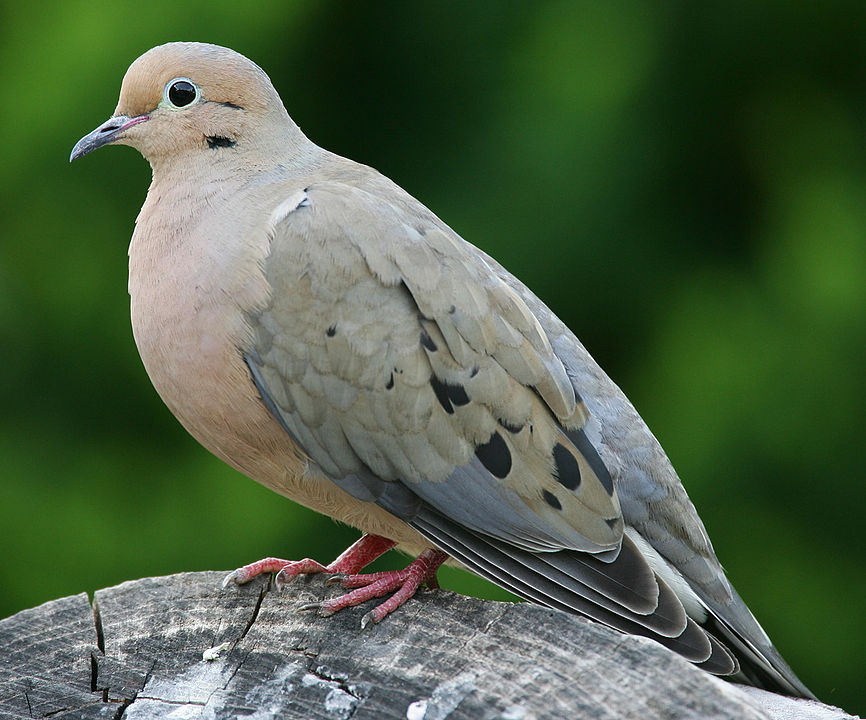
Coloration and Markings: The Mourning Dove is often quite plump, with a gray back and large, gray wings which have a healthy coloration of light brown or tan towards their centers, as well as some large, distinctive black spots. Also quite distinct are their long, thin gray tails, which are unique to this species among other North American Doves. The underbelly and breast of this bird are white with a heavy dose of tan coloration and facially, we have more tan color as well as a lovely white eyering and a straight, medium-length black bill.
Size: These Doves measure in at 9.1 – 13.4 inches from tip to tail and have wingspans of approximately 17.7 inches wide.
Habitat: These birds shy away from dense woods, preferring fields, grasslands, or even bare earth when it comes to foraging. They are quite comfortable in the city as well and it’s not uncommon to spot one waddling down the sidewalk.
Diet: Hulled Black Oil Sunflower seeds, White Proso millet, and cracked corn are 3 favorites of the Mourning Dove that can increase your chances of a feeder visit.
Northern Cardinal – Cardinalis cardinalis
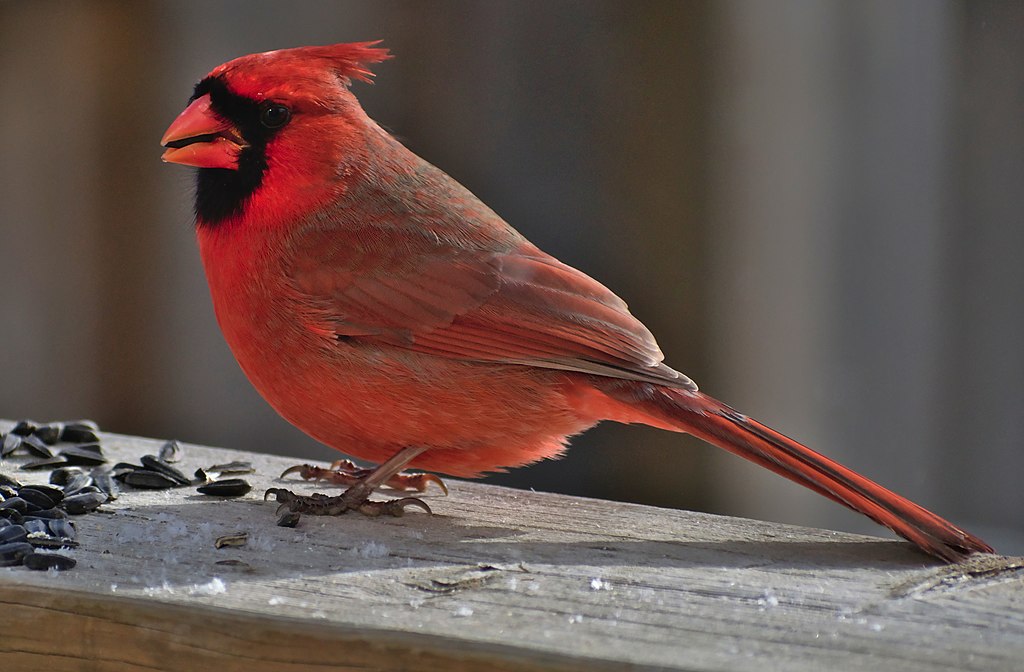
Coloration and Markings: Male Northern Cardinals are easily identifiable, being almost completely red all over their bodies. They have medium-length wings and long, red tails, and facially you notice their signature black mask which covers the eyes and continues down to display in an angular fashion at the bird’s chin. They have large, stout, and medium-length conical orange-red bills and a beautiful, large crest. Females have the same look but different coloration, being a lovely brown all over with tinges of red present throughout the plumage.
Size: These birds measure in at 8.3 – 9.1 inches in length and have wingspans of 9.8 to 12.2 inches in width.
Habitat: While you can find them at the forest’s edge if there is a bit of cover, these birds are more commonly found in places like woodlots, parks, orchards, and backyards with well-stocked feeders.
Diet: Black Oil Sunflower seeds, cracked corn, and chopped apples are an easy and effective lure for the Northern Cardinal.
Blue Jay – Cyanocitta cristata
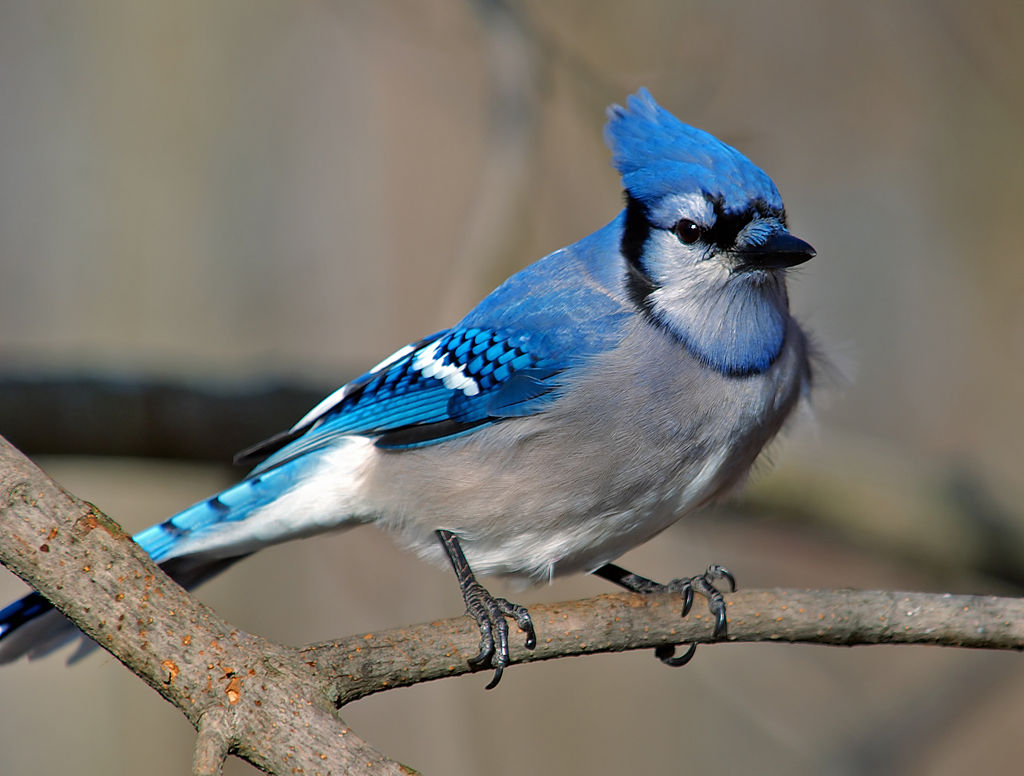
Coloration and Markings: Blue Jays have quite striking plumage, with deep blue backs, medium-length wings, and long, blue tails with white undersides and outer feathers. The wings show a white wingbar on each, as well as some ‘scaling’ patters of light blue outlined in black just above and below the wingbar as well as some large, white spots outlined in black towards the lower center of the wings. The tails have a more symmetrical design, with squares going down the tail on opposing sides that are light blue outlined in darker blue. The underbelly and breast of this bird are a snowy white, broken only at the throat where you will see a black line coming down from the back of the majestic, light-blue crest and circling around to the other side. Facially, this bird has a white face with a rather abstract, thin mask of black and a long, straight, and thick black bill.
Size: Roughly Robin-sized, these birds measure in at 9.8 – 11.8 inches from head to tail and have wingspans of 13.4 to 16.9 inches wide.
Habitat: Blue Jays love the forest’s edge and are especially fond of Oak trees for their delicious acorns. You can also find them in woodlots and around cities, as they are not shy, and if you leave a little something out in your backyard feeder then you might just make a new, blue friend!
Diet: Blue Jays are quite fond of suet, crushed peanuts, and Black Oil Sunflower seeds. They also like birdbaths so if you’ve got one, be sure to get it ready!
Vermont’s Birds of Spring, Summer, and Early Fall
When the grass starts poking out of out of the thinning snow then things are about to get busy in Vermont, with daily arrivals of migrant birds that will for quite some time. See if you can spot one of these birds during the warmer months:
- Red-eyed Vireo
- Gray Catbird
- Chestnut-sided Warbler
- Great Crested Flycatcher
- Blue-headed Vireo
Red-eyed Vireo – Vireo olivaceus
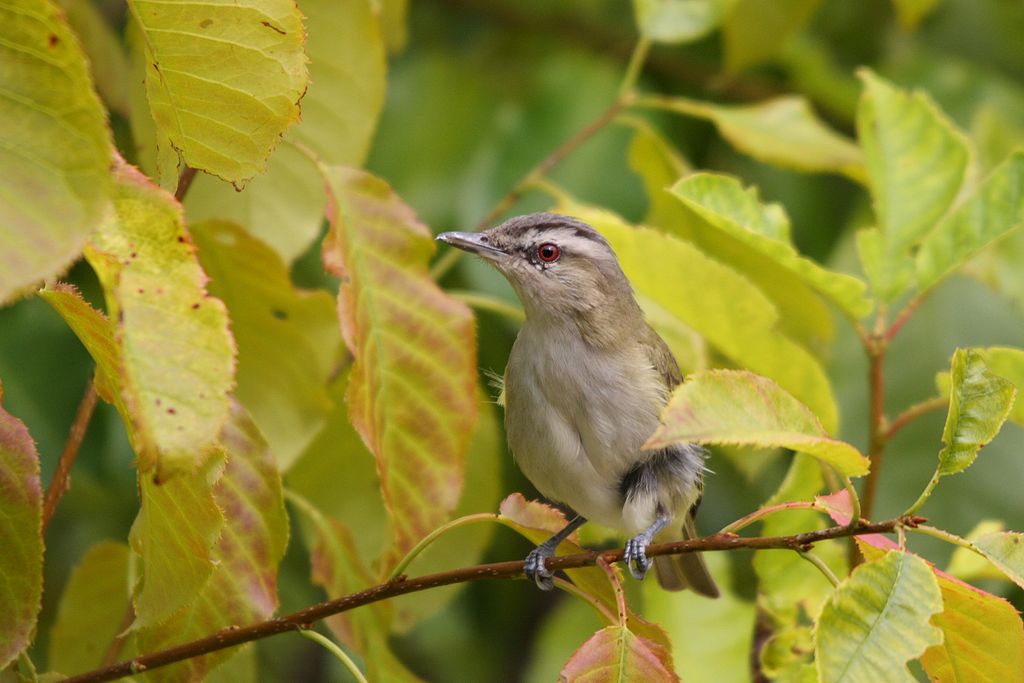
Coloration and Markings: Red-eyed Vireos have yellow-green backs with medium-length, gray wings with a heavy dose of greens and yellows in the mix and short, perky green, yellow, and gray tails. They have white rumps and a white underbelly and breast with a little yellow present just below the wings and facially, these birds have white chins and white around the eyes, with a black eyebrow mark above a thin, olive eyeline. The cheek, neck, and the back of the head are greenish yellow and this bird has a gray crown and a medium-length grayish-black bill that is straight but with a minute hook at the tip. Note, only the adults will have red eyes, with juveniles displaying only dark ones.
Size: These birds measure in at 4.7 – 5.1 inches in length and have wingspans of 9.1 to 9.8 inches wide.
Habitat: These Vireos love deciduous woods, finding shelter most commonly in trees where the leaves are wide and concealing. They do range out a bit, however, so when it’s warm you can find them in other types of woods as well as woodlots, parks, and backyards with freshly-filled feeders.
Diet: While these birds primarily eat insects, they do occasionally add a little fruit to their diet. Try leaving out some whole blueberries, chopped cherries, or even a halved-orange in your feeders and see what happens. You might just get the attention of the Red-eyed Vireo.
Gray Catbird – Dumetella carolinensis

Coloration and Markings: Easy to identify, Gray Catbirds have stone-gray backs which look a little humped, as well as gray medium-length wings and long, rounded tails which are most commonly dark gray to black above and below, with the exception of some foxy reddish-brown coloration close to the rump. The underbelly and breast of this bird are the same stone-gray and this carries up into the face, broken only by a small amount of black in front of the eyes, a black cap, and a long, straight black bill.
Size: About the same size as a Robin, Catbirds measure in at 8.3 – 9.4 inches in length and have wingspans of 8.7 to 11.8 inches in width.
Habitat: Catbirds like a little cover, so look for them around small trees which have brambles, brush, or bushes close by and they also favor streams with such cover as well.
Diet: These birds live berries and small fruits and you can attract them with whole blueberries and grapes if you’ve got them or with some chopped, sweet fruit that you have on hand.
Chestnut-sided Warbler – Setophaga pensylvanica

Coloration and Markings: Chestnut-sided Warblers have yellowish, gray-streaked backs (or sometimes mostly gray) and medium-length gray wings which display 2 white wingbars and some yellowish coloration towards the centers. They have medium-length to long tails which are notched and gray, with some white on the undersides coming from the rump. The underbelly and breast of this bird are white, excepting the namesake patches of chestnut color just under the wings at the shoulder area of the breast. Facially, these birds have white faces with a black mask over the eyes, with the color also arcing down in front of the cheek. There is a thin line of black at the back of the head and this bird has a striking, bright-yellow crown. These birds have thick, straight, and medium-length black bills.
Size: Relatively small, these birds measure in at 4.7 – 5.5 inches in length and have wingspans of 7.5 to 8.3 inches wide.
Habitat: These birds love deciduous woods and are also found around Oak trees, preferring areas that are thick with brush, bramble, shrubs, and thorns.
Diet: While primarily insectivorous, this bird does supplement its diet with the occasional fruits. They are more likely to visit your garden than your feeder but you can try leaving out some whole blueberries or chopped cherries and you might just get their attentions.
Great Crested Flycatcher – Myiarchus crinitus

Coloration and Markings: Great Crested Flycatchers are mostly gray birds with varying amounts of reddish- brown in their plumage. They have gray backs with medium-length gray wings and long, notched tails which are gray or gray and reddish-brown. The underbelly and breast of this bird are a delightful mix of white and light yellow color and facially, these birds have a gray face with a white chin and though the name say’s it is great, they actually have a small, if pretty gray crest. These birds have long, straight bills that are black or sometimes black and reddish-brown and it’s not uncommon to see a little white on the lower bill.
Size: These birds measure in at 6.7 – 8.3 inches in length and have wingspans of approximately 13.4 inches wide.
Habitat: These birds prefer open woods and also spend a lot of time in woodlots. When it gets colder, they prefer a little more dense woods but only by a fraction. Look for them wherever you find trees with a bit of shrub cover and a good view of the surroundings.
Diet: These birds prefer insects, so leave out some live or dried mealworms if you’ve got them. They supplement with small berries as well, so blueberries might just get you a visit from the Great Crested Flycatcher.
Blue-headed Vireo – Vireo solitarius

Coloration and Markings: Blue-headed Vireos have backs which are gray with a mix of mossy green color with medium length gray wings and tails, the wings displaying 2 white wingbars and some light green coloration, as well as some white edging towards the center of the inner wing. There is white edging on the tails as well and the underbelly and breast of this bird are white with some minor green flanking just beneath the wings. This white carries up into the face to take up the chin and the throat area immediately below, while some lighter colored gray at the back of the head and a fuller gray at the cheeks and upper portion of the face. Finally, this bird has white ‘spectacles’ and a straight, medium-length black or black and white bill (with the white manifesting on the lower bill if present).
Size: These birds measure in at 4.7 – 5.9 inches in length and have wingspans of 8.7 to 9.5 inches wide.
Habitat: When it is warm, these birds prefer wooded areas that are montane or arboreal in nature, though in the winter all bets are off and you can find them just about anywhere that there are trees with a bit of brush cover.
Diet: Mealworms and chopped up apples or whole, small blueberries are a great way to get and keep the attentions of the Blue-headed Vireo.
Vermont’s Fall and Winter Birds
Vermont has some pretty solid winters, with lows as far down as 2 degrees Fahrenheit. Despite this challenging chill, a number of birds are alive and well and foraging at this time. Leave a little something out to help these bold birds and if you have a heated birdbath, consider putting it out. Things are tough out there and your favorite feathered friends could use a helping hand. See if you can spot one of these winter-warriors outside this year:
- Dark-eyed Junco
- Tufted Titmouse
- Bohemian Waxwing
- Snow Bunting
- Horned Lark
Dark-eyed Junco – Junco hyemalis

Coloration and Markings: Dark-eyed Juncos come with a lot of color variance depending on region, but the basic ‘template’ is a bird with a dark gray or brown back as well as medium-length, gray wings and long, gray tails with white undersides. The underbelly and breast of this bird is white, with a flanking of gray beginning at the underbelly and thickening the sides as it goes up. This gives the effect as if the bird was dipped in white paint, with the lower 3rd of the body often evenly colored in white. The face of this bird is dark gray or brown and Juncos have stout, medium-length, and conical pink bills.
Size: These birds measure in at 5.5 – 6.3 inches in length and have wingspans of 7.1 to 9.8 inches wide.
Habitat: When it is warm these birds prefer coniferous or coniferous-deciduous mixed woods but in winter, you can find them in parks, woodlots, and backyards with well-stocked feeders. Be sure to leave a little something out for them, especially in winter, to help to keep your little feathered friends warm and full.
Diet: Black Oil Sunflower seeds, White Proso millet, and cracked corn are all that you need to make a well-received feast for the Dark-eyed Junco.
Tufted Titmouse – Baeolophus bicolor
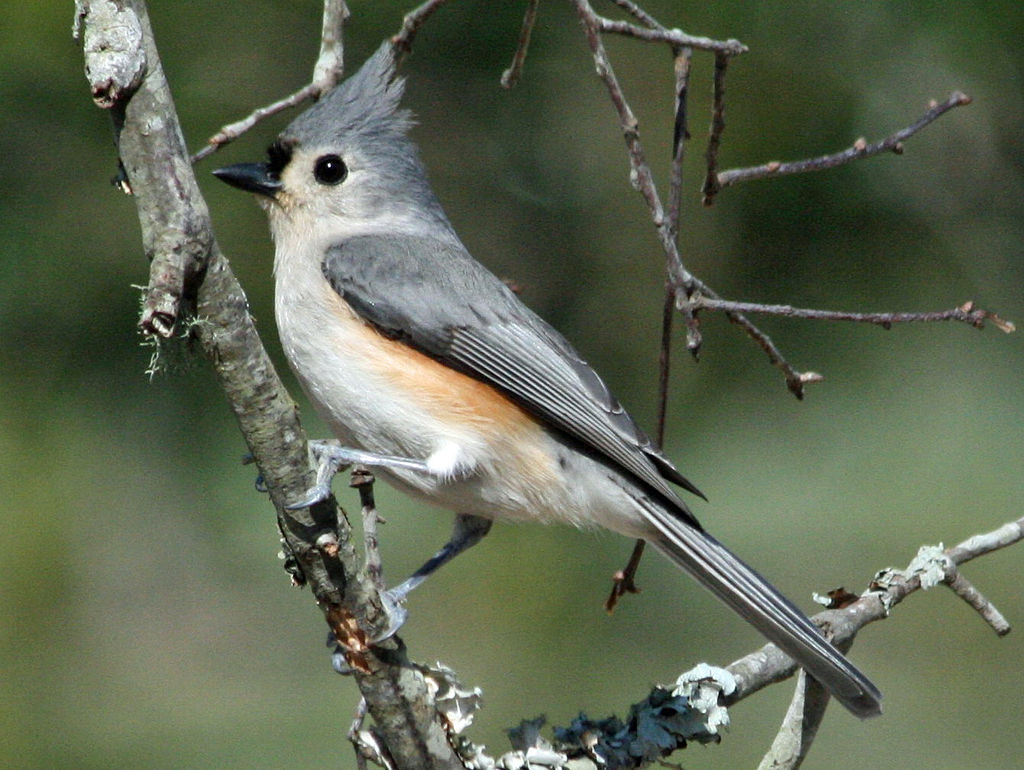
Coloration and Markings: The Tufted Titmouse is a beautiful bird, with a blue-gray back and medium-length, blue-gray wings and long, blue-gray tails. The tails are lighter in color underneath and the underbelly and breast of this bird are white, with a faint cast of peach color to them on the lower sides and sometimes in the underbelly. Facially, these birds have white faces with delightful blue-gray crests, which have some color coming down from them to the back of the head and to lightly frame the eyes from above and behind. A distinctive black mark is immediately above the small, thick, and triangular black bill.
Size: These birds measure in at 5.5 – 6.3 inches in length and have wingspans of 7.9 to 10.2 inches wide.
Habitat: These birds like to spend their time in evergreen or deciduous woods, but they do range out quite often, visiting parks, backyards, and the occasional orchard or garden if they find one.
Diet: Suet, crunchy peanut butter, and hulled Black Oil Sunflower seeds are all favorites of the Tufted Titmouse.
Bohemian Waxwing – Bombycilla garrulus
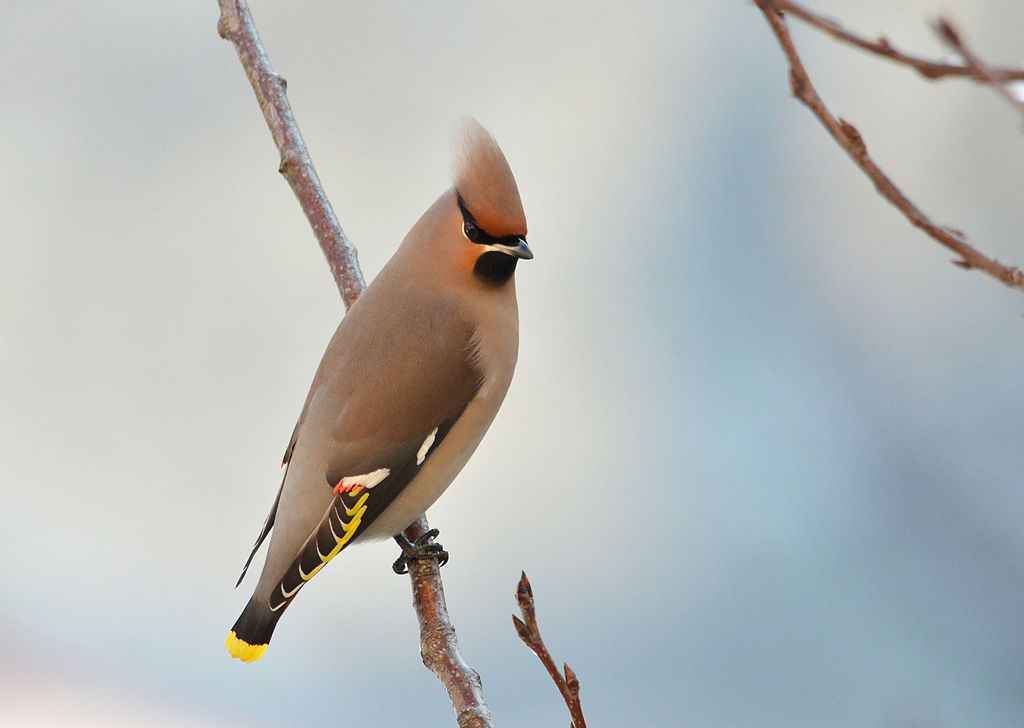
Coloration and Markings: Bohemian Waxwings look quite exotic, with gray backs and medium-length gray wings, and short, stocky gray tails which are yellow-tipped and peach color underneath. The wings display white patches and red, waxy tips and sometimes a touch of yellow towards the outer wingtips. The underbelly and breast of this bird are light gray with some brown flanking dimly on the sides and facially, these birds have largely gray faces with a heavy dose of peach color around the cheeks, back of the head, and above the eyes. They have lovely crests as well as black chins and a black mask that curves upward behind the eyes, terminating just before the back of the head. These birds have short, stout black bills. Juvenile Waxwings will lack the facial saturation of peach color and red-tip markings and their underbelly and breast will be a bit more gray, with streaking.
Size: These birds measure around 6.3 – 7.5 inches from tip to tail and have wingspans averaging about 13 inches wide.
Habitat: These birds prefer open-areas in evergreen woods but they do range out, visiting orchards, parks, and haunting the occasional streams where there is a bit of cover and good foraging.
Diet: These birds love fruit and though they are more likely to visit your garden, you can try leaving out various fruits such as raisins, cherries, or even chopped apples to tempt the Bohemian Waxwing into a backyard feeder visit.
Snow Bunting – Plectrophenax nivalis

Coloration and Markings: Male Snow Buntings can have a lot of variance in their plumage but typically in breeding season you can expect a white back, with long wings and medium-length tails, both white, with some black towards the tips of the wings and some black on the tops of the tail. The underbelly and breast of this bird are generally snowy-white and facially, they have a white face with a short, stocky, and straight black bill. Females look much the same, with browns instead of blacks on the upper body, and non-breeding males will exhibit a rusty patch of color at the shoulder and ‘ear’ area, while non-breeding females will have rust color at the face and the breast. Note than when it’s not breeding season, both genders will have orange, rather than black bills.
Size: These birds measure in at approximately 5.9 inches from tip to tail and have wingspans averaging 11.8 inches wide.
Habitat: These birds love snowy, rocky areas as well as coastlines or the shores of lakes and rivers, provided there is a little brush cover.
Diet: Hulled Black Oil Sunflower seeds and Nyjer thistle might be just what you need to make a new friend of a hungry Snow Bunting. Just be sure to use a ground level feeder and sprinkle a bit of seed at the base for best results.
Horned Lark – Eremophila alpestris

Coloration and Markings: Male Horned Larks have a simple, but pleasing coloration, with an overall sandy or reddish-brown coloration on their backs, long wings, and medium-length tails. The tails have white undersides and the underbelly and breast of this bird are a grayish white with sandy brown flanking and with a white rump. Facially, things get a little more complicated, and this bird has a yellow chin and some yellow along the base of the throat that extends halfway towards the back of the head. This bird also has a black band at the base of the throat and a black mask, which cuves downwards over the cheek as it widens. Above the mask, this bird has a tan coloration and finally a thin, black ring is present encircling the forehead and ending in the back with small, horn-like tufts. These birds have short, stout, and slightly curved black bills. Females will have the same coloration but the colors are less immaculately defined in their boundaries, seeming to run together more than you would see on the males.
Size: These birds measure in at 6.3 – 7.9 inches in length and have wingspans of 11.8 to 13.4 inches wide.
Habitat: While you can spot them in tundra regions, grasslands, and areas with a lot of desert scrub, these birds prefer their ground to be as bare as possible.
Diet: Insects make up a large part of this bird’s diet, but they do also like to eat berries. If you have some growing in your garden then this is best, but you might have a little luck with blueberries or blackberries in your feeder as well.
Supporting cast (Other Backyard Birds of Vermont that might pay you a visit)
We like to include an extra helping of birds which you can see year-round which we call our ‘Supporting Cast’ birds. These birds are waiting at any time of the year and may well make an appearance to your backyard feeder, provided you’ve left something out which you know that they love. See if you can spot one of these Supporting cast birds or lure them to your backyard this year:
- American Robin
- Downy Woodpecker
- White-breasted Nuthatch
- Eastern Bluebird
- American Crow
American Robin – Turdus migratorius
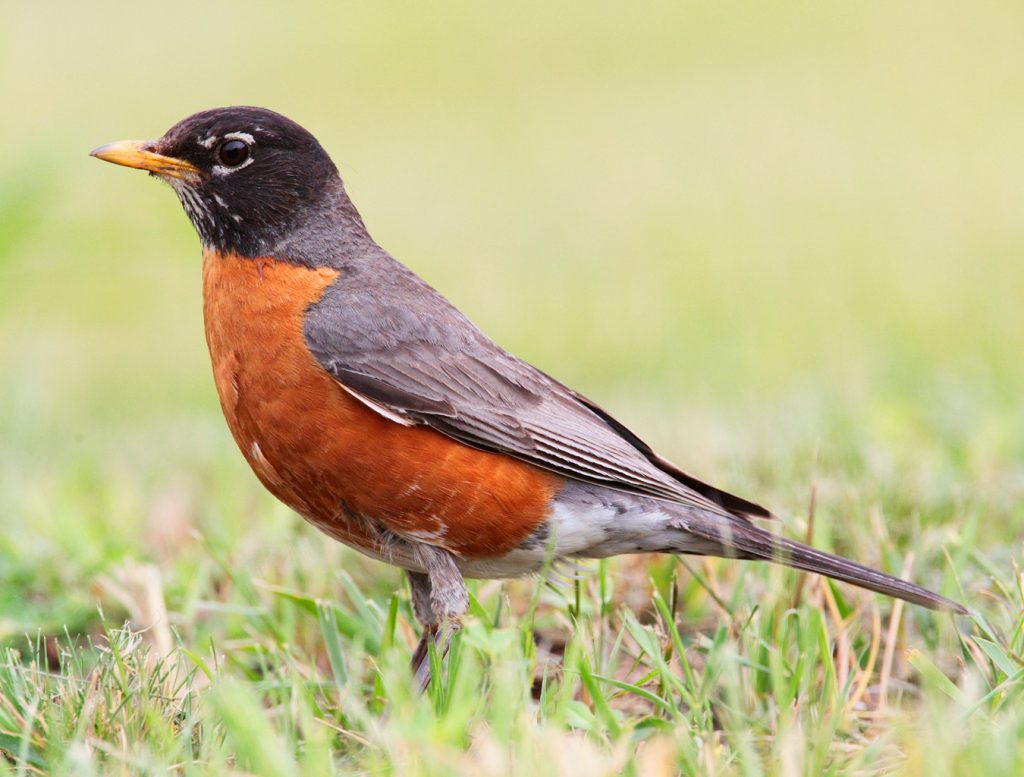
Coloration and Markings: American Robins are easy to identify, with dark grayish-brown backs, medium-length wings, and long tails of the same color. The tail will have some white on the undersides, coming from the rump, and the underbelly and breast of this bird are a lovely reddish-orange. Facially, these birds have black heads with a white, fragmented eyering and a medium-length, slightly curved yellow bill. Females tend to look much the same, though the color of the head will be much dimmer.
Size: These birds measure in at 7.9 – 11 inches in length and have wingspans of 12.2 to 15.8 inches wide.
Habitat: Robins may be found in a lot of places, so you can look for these bold birds in tundra regions, deciduous or pine woods, parks, orchards, and even golf courses. They are happy to visit backyard feeders, provided that you’ve left something thoughtful out for them that they like.
Diet: Crushed peanuts, raisins, and suet are all good feeder-food choices that make for happy American Robins.
Downy Woodpecker – Picoides pubescens
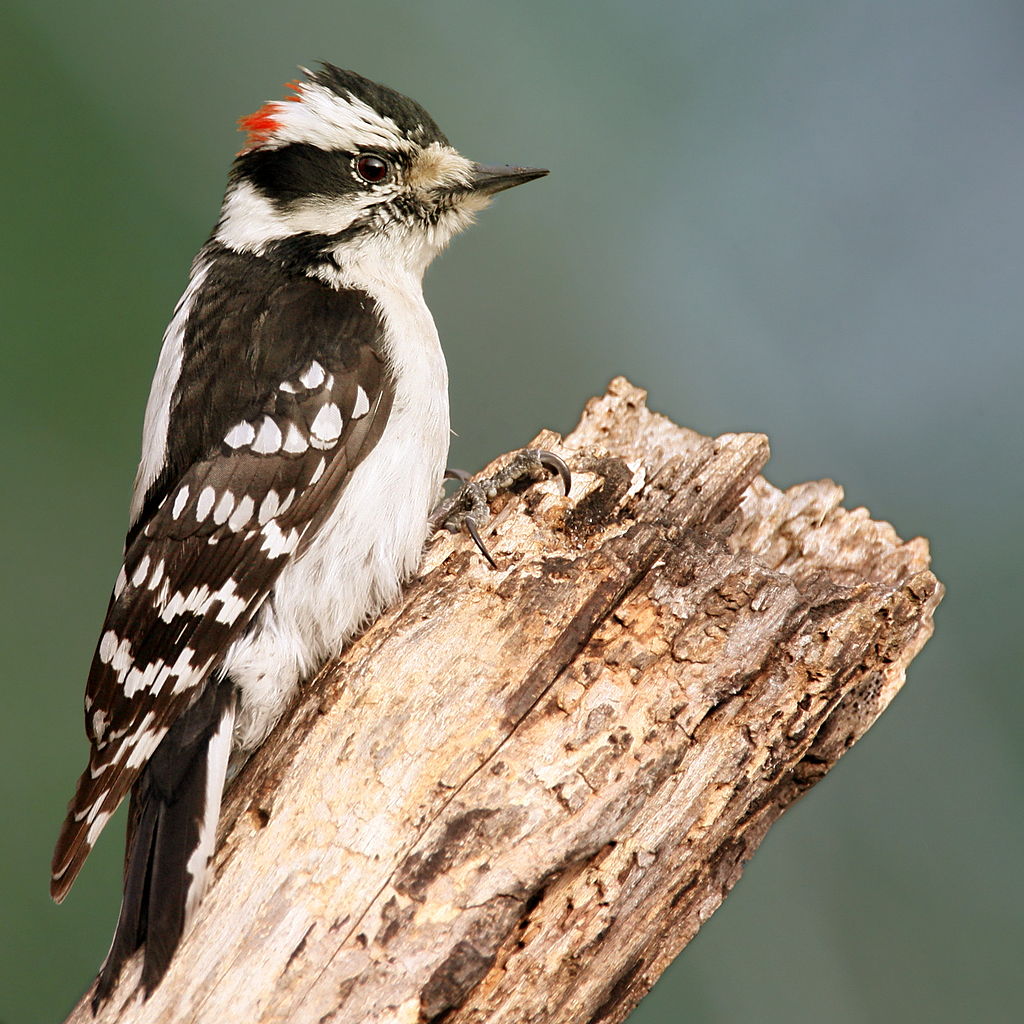
Coloration and Markings: Downie Woodpeckers have white backs with long, black wings and short, notched black tails which are white on the undersides. The wings have a distinctive pattern of striping that starts just under the shoulders and is made of blocky, white spots, giving it a checkerboard look. The underbelly and breast of this bird are white and facially, this bird has a white face with a black mustache line, a black ‘bandit’ type mask, and a black cap that terminates at a red spot in the back of the head for males (females will just have a black cap). These birds have medium-length, thin, and straight black bills.
Size: The smallest North American Woodpecker, these little birds measure in at 5.5 – 6.7 inches in length and have wingspans of 9.8 to 11.8 inches long.
Habitat: Downies like open wooded areas, especially with high weeds or brush nearby as they often drop from branches down into this cover to forage. You can also find them in parks, gardens, and backyards with well-stocked feeders.
Diet: These birds love suet, chunky peanut butter, and they’ll even sip on the sugar water in your Hummingbird feeder sometimes.
White-breasted Nuthatch – Sitta carolinensis

Coloration and Markings: The White-breasted Nuthatch has a bluish-gray back with long, blue-gray wings that have some black edging and what looks like a very thin, white wingbar, and a short, blue-gray tail that is white on the underside. They have a white underbelly and breast, with a distinct reddish-brown spot on the underbelly, and facially, these birds have mostly white faces with a thin, black line moving up diagonally from the back of the eyes. This is just under the long, black cap that goes to the nape of the neck and this bird also has a thick, straight, and long bill which is often black on top and white below.
Size: These birds measure in at 5.1 to 5.5 inches in length and have wingspans of 7.9 to 10.6 inches wide.
Habitat: White-breasted Nuthatches like open wooded areas and are especially fond of deciduous regions. You can find them in coniferous woods as well or at the forests edge and the occasional well-stocked backyard feeder.
Diet: Suet and peanut butter, mixed together, is a tried-and-true favorite on the White-breasted Nuthatch.
Eastern Bluebird – Sialia sialis
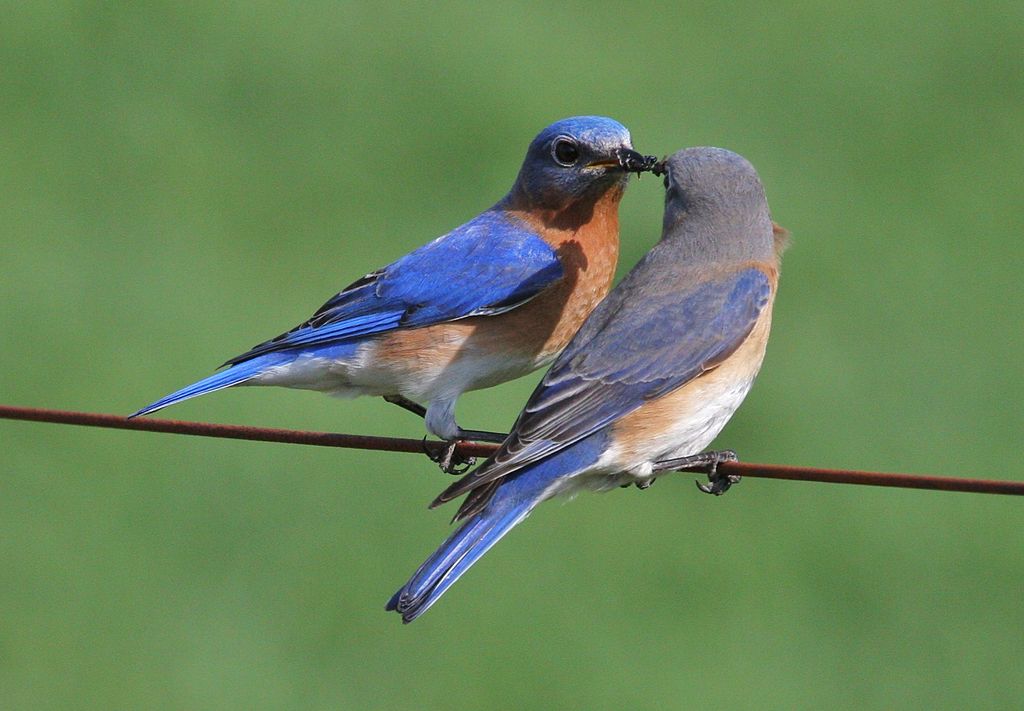
Coloration and Markings: Male Bluebirds have lovely plumage, with a deep blue back, long blue wings and a short blue tail. The rump of this bird is white as is the breast and underbelly, though it is flanked on the sides by an orange or brick-red ‘vest’ which grows in density as it approaches the breast. This orange extends up to the chin and throat of the bird and spread horizontally to the back of the next. The remainder of the facial coloration will be deep blue, like the back and wings. These birds have short, stout, and straight black bills with a minute curvature noticeable in the upper bill. Females will have gray heads with light blue infused in their gray wings and tail.
Size: These birds measure in at 6.3 – 8.3 inches from head to tail and have wingspans of 9.8 to 12.6 inches wide.
Habitat: Bluebirds prefer open areas of woods, so look for them at the forest’s edge, meadows, clearings, and copses. They do visit the occasional backyard, as well, and are quite receptive to nesting boxes so consider leaving one out if you’d like to tempt a possible Bluebird tenant into your backyard.
Diet: Black Oil Sunflower seeds, raisins, and suet are 3 favorites of the Eastern Bluebird which you may use in order to get (and possibly to keep) their attentions.
American Crow – Corvus brachyrhynchos

Coloration and Markings: American Crows are easy to identify, being completely black from top to bottom (even their legs and feet!). They have long, broad wings and short, squared or rounded tails and facially, they have a very distinct straight, black bill that displays a noticeable curve in the upper half of the bill.
Size: Crows are big birds, measuring in at 15.8 – 20.9 inches from tip to tail and with wingspans og 33.5 to 39.4 inches wide.
Habitat: While the birds are fond of fields and forest clearings you can also find them all over town, scoping out meals from phone lines and fences.
Diet: While Crows will eat just about anything it is generally a good idea to offer them something healthy. Try leaving out favorites like crushed peanuts, Black Oil Sunflower seeds, fruits, and even veggies. You can also find ‘puzzle feeders’ to take advantage of the Crow’s curious nature and you should consider it, as these clever birds seem to have fun and you get to see it!
Vermont Bird Buffet
If you want some help in selecting the proper combination of foods to attract the birds that you want to see then we have some good for you today. We’re sharing some tips from the Vermont Fish and Wildlife Department in regards to these foods and adding a suggestion or two of our own as well. If you’d like to read the citing article, just take a look in our references section, and in the meantime be sure to add one or more of the following to your backyard feeders:
- White Proso millet
- Nyjer thistle
- Black Oil Sunflower seeds
- Crunchy peanut butter
- Grape jelly
- Suet
- Rolled oats
Vermont Birding Hot Spots
While you can sometimes see new birds while you are just walking around in the city, from time to time it is still nice to get out in the wild a little and see these little angels in their native element. If you want to get some views or even some pics like a real Chirparazzo, here are some spots all over Vermont for you to consider:
- Northern hotspot – Cambridge Greenway
- Eastern hotspot – Cross Vermont Trail
- Southern hotspot – Hoot, Toot and Whistle Trail
- Western hotspot – Battell Woods Trail
- Central hotspot – Montpelier Recreation Path (Winooski Path)
Detailed descriptions of each location as well as information regarding visiting and what birds you can see at these locations may be found at https://www.traillink.com/stateactivity/vt-birding-trails/
Some Final Words
Today we have discussed the popular backyard birds of Vermont and we hope that you have enjoyed this little journey into birding in the Green Mountain state. We hope that you will take advantage of these tips and with a little advance preparation, who knows what winged wonders will be visiting your backyard feeders next? Until next time, we wish you our birding best!
